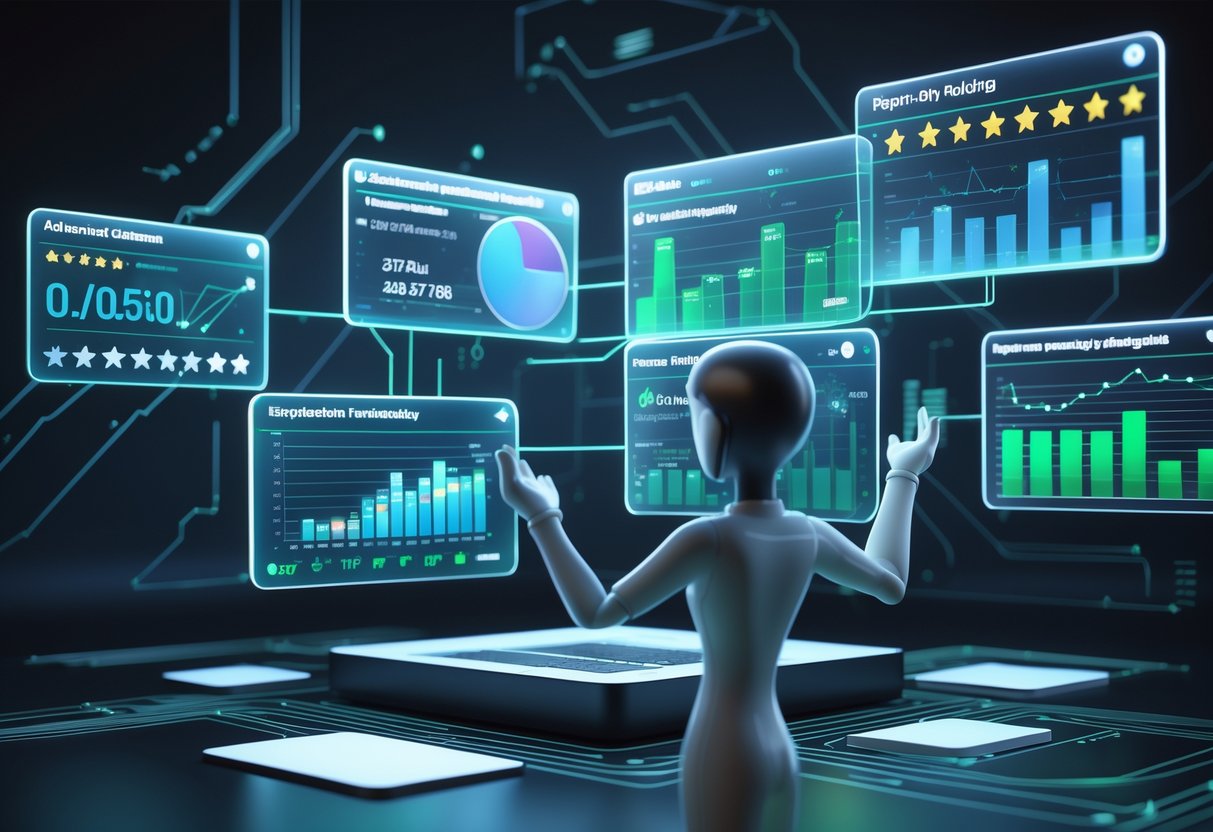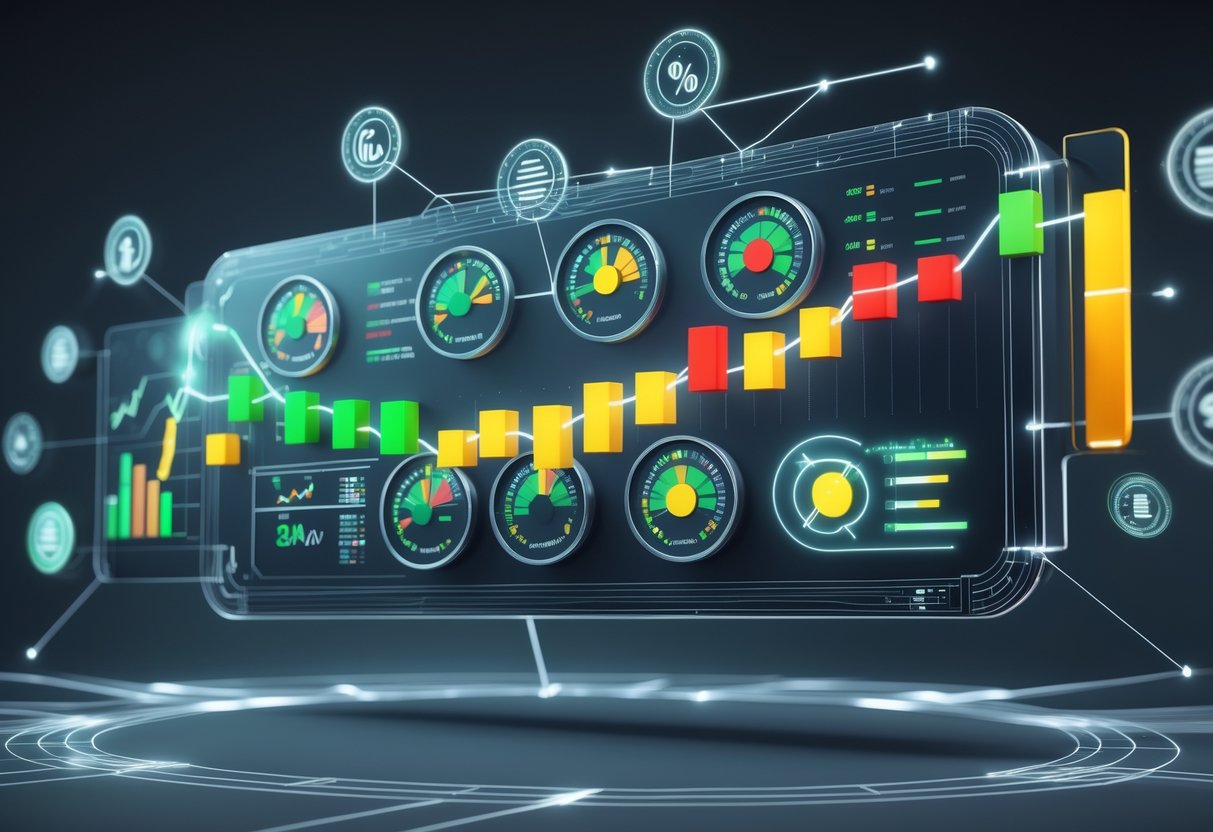Economy Rating Systems: How They Work, Shape Experiences, and Influence Platforms
Updated On: November 13, 2025 by Aaron Connolly
Core Principles of Economy Rating Systems

Economy rating systems rely on specific methods to measure and compare how different economic models actually perform. They focus on things like growth, stability, and fairness to help us figure out which approaches really work for different countries and situations.
Definition and Purpose of Economy Rating Systems
Economy rating systems act as tools that measure and rank the performance of different economic models. We use them to compare countries and see which economic approaches truly deliver.
Governments depend on these systems to shape policy. Businesses look at the ratings when deciding where to invest. Instead of just relying on theory, rating systems pull from real data.
Their main goal? To answer questions that matter: Which countries have stable economies? Where do people enjoy better living standards? Which systems actually create more jobs?
Rating systems usually measure:
- Economic growth rates
- Employment levels
- Income distribution
- Price stability
- Government debt levels
We need these numbers because economic systems touch millions of lives. A good rating system helps us catch issues early and highlights what’s working well.
Essential Components of a Rating System
Every solid economy rating system needs a few basic parts to really work. These pieces make sure the ratings stay fair and accurate.
Data collection is where it all starts. Rating systems gather info on employment, prices, trade, and government spending. They need current, trustworthy sources for this data.
Measurement criteria set the definition of success. Some systems put growth first. Others care more about cutting poverty or protecting the environment.
| Component | Purpose | Example |
|---|---|---|
| Economic indicators | Measure performance | GDP growth, unemployment rate |
| Weighting system | Show what matters most | Growth vs equality priorities |
| Comparison method | Rank different economies | Country rankings or scores |
Transparency matters, too. Good systems lay out their methods clearly so people can see what’s behind the numbers.
They also need regular updates. Economic conditions change fast, so ratings have to keep up.
Types of Economy Rating Systems
We can sort economy rating systems into a few main groups, depending on what they measure and how they operate.
Growth-focused systems put economic expansion at the center. They look at GDP growth, productivity, and business investment. Fast-growing countries get the top marks here.
Stability-focused systems care more about steady, consistent performance. These systems check inflation, government debt, and the health of financial systems. They reward predictability.
Mixed approach systems try to balance goals. They weigh both economic growth and social factors, like income equality or environmental protection.
Sector-specific ratings zoom in on particular areas. Some focus only on manufacturing, while others look at services or tech.
| Rating Type | Main Focus | Best For |
|---|---|---|
| Growth-based | Economic expansion | Developing countries |
| Stability-based | Consistent performance | Mature economies |
| Social-focused | Living standards | Policy planning |
Each type serves its own purpose. Investors tend to prefer growth-focused ratings. Citizens might care more about quality-of-life measures.
How Rating Systems Function in Digital Economies
Digital rating systems help strangers trust each other by collecting user feedback and showing reputation scores. These systems pull data from service providers and customers, then display it in ways that help users make snap decisions.
Platform-Mediated Reputation Systems
Platforms like Uber and Airbnb step in as reputation middlemen. They do more than just display scores—they shape how trust works between users.
Platforms collect ratings from both sides after each transaction. A driver rates a passenger, and the passenger rates the driver. This two-way feedback creates accountability for everyone.
Key Platform Functions:
- Store and calculate reputation scores
- Display ratings to help users choose
- Set rules about when ratings appear
- Remove fake or unfair reviews
Some platforms break things down with detailed scores. Others just use simple star averages. TaskRabbit, for example, shows ratings for specific skills, while Uber sticks to overall scores.
They also try to protect new users who don’t have ratings yet. Sometimes they highlight a complete profile or verified identity to help newcomers land their first job or ride.
People trust a platform’s rating system if they trust the platform itself. That’s a big part of why Airbnb’s ratings work.
Data Collection and Feedback Mechanisms
Rating systems don’t just rely on star ratings. Platforms mix in user reviews, booking data, response times, and cancellation rates.
Most systems ask for ratings right after a transaction. That way, they catch fresh impressions before people forget. Push notifications and emails nudge users to leave their feedback.
Common Data Points Collected:
- Star ratings (1-5 scale)
- Written review comments
- Response time metrics
- Completion rates
- User behaviour patterns
Platforms use algorithms to sniff out fake reviews or strange patterns. They look for things like a bunch of reviews from the same IP address or overly glowing language.
Some systems give more weight to recent reviews. If a host’s rating improved last month, that counts more than a review from two years ago. This helps people recover from old mistakes.
Timing matters, too. Some platforms wait until both parties have submitted ratings before revealing them. That helps prevent revenge ratings.
Interpretation of Ratings by Users
Users make quick decisions based on ratings, but they often don’t know what the numbers really mean. Most folks glance at the overall star rating, then skim through recent written reviews.
A 4.2-star rating might look fine, but if most providers score above 4.5, it’s a red flag. People learn the platform’s standards after a while.
How Users Typically Read Ratings:
- Check the overall star rating first
- Look for recent negative reviews
- Count the total number of reviews
- Scan for specific issues (cleanliness, punctuality)
New users sometimes read ratings wrong. Someone new to Uber might get nervous about a 4.7-star driver, not realising that’s actually good.
Written reviews usually carry more weight than stars, especially for big decisions. People dig into the comments for details that matter to them—like noise for an Airbnb or driving style for an Uber.
Users also size up the reviewer. If someone leaves harsh ratings everywhere or only has one review, people might ignore their complaints.
Rating Systems in Ride-Hailing Platforms
Ride-hailing platforms use two-way rating systems. Both drivers and passengers rate each other after trips. These ratings directly affect driver earnings, account access, and passenger experiences.
Uber’s Economy Rating Model
Uber runs on a five-star system that doubles as quality control and a way to manage drivers. Drivers have to keep their ratings above certain thresholds to stay on the platform.
The company usually wants drivers to stay above 4.6 stars. Drop below that, and drivers get warnings or even booted off the app.
Key Rating Thresholds:
- 4.6+ stars: Good standing
- 4.2-4.5 stars: Warning period
- Below 4.2 stars: Risk of deactivation
This setup pushes drivers to deliver great service. But it can also feel unfair, since passengers have all kinds of expectations.
Some passengers think a four-star rating is good, not realising it actually hurts drivers. The system doesn’t always account for things drivers can’t control, like traffic or tricky pickup spots.
Peer-to-Peer Feedback in Ride-Hailing
Unlike old-school services where only the customer rates the provider, ride-hailing lets both sides rate each other. Drivers rate passengers, and those ratings can affect whether drivers accept future rides from them.
Passengers with low ratings might find it harder to get rides. The two-way feedback encourages everyone to act decently.
Common Rating Factors:
- For drivers: Punctuality, car cleanliness, driving skill, friendliness
- For passengers: Politeness, punctuality, cleanliness, correct pickup location
This mutual system helps strangers trust each other in a car. It also gives drivers a bit more say, compared to regular taxis.
Still, it’s not perfect. Studies show that ratings sometimes reflect bias—like race or gender—instead of actual service quality.
Role in Driver and Rider Experiences
Ratings shape how people act on ride-hailing apps. Drivers often go the extra mile—offering water, mints, or chargers—to keep their scores up.
For drivers, ratings mean income and job security. A low score might mean fewer rides or even losing access to the app. That’s a lot of pressure for gig workers.
Driver Impacts:
- Account deactivation risks
- Fewer trip requests
- Exclusion from premium services
- Loss of income
Passengers get more consistent service, but many don’t realise how much their ratings matter. One bad rating can really hurt a driver’s average.
The whole system can make both sides anxious. Drivers worry about unfair reviews, while passengers sometimes feel pushed to give five stars even for average rides.
Some companies are trying out more detailed feedback systems, but the five-star model still rules the industry.
The Influence of Ratings on User Behaviour
Rating systems change how people act in digital marketplaces. They push both service providers and customers to keep standards high and feed continuous feedback loops.
Shaping Worker and Customer Choices
Rating systems directly shape how workers and customers behave on gig platforms. Service providers adjust their actions to earn better reviews, sometimes going above and beyond.
Uber drivers keep their cars extra clean and hand out bottled water. Airbnb hosts answer messages fast and share local tips. These aren’t just nice touches—they’re strategies to keep ratings up.
Customers change their behaviour, too. Riders tend to be more polite. Guests treat rentals with more respect. The two-way system keeps everyone accountable.
Bad ratings hit hard. Workers with low scores get fewer jobs and might lose access to the platform. Customers with poor ratings struggle to book top providers.
This creates a quality spiral. High-rated workers attract better customers, leading to more positive experiences and even higher ratings.
Feedback Loops and Behavioural Change
Ratings set off cycles that reinforce certain behaviours. Each review shapes what happens next, fueling self-reinforcing patterns.
Positive feedback makes workers stick with what works. A delivery driver who gets five stars for being friendly will likely keep it up. Over time, this builds consistency.
Negative feedback sparks quick changes. People often tweak their approach after a bad rating, sometimes overdoing it to avoid more criticism.
Timing matters a lot. Instant ratings after a transaction tie actions directly to results, making the feedback stick.
Rating anxiety is real for many workers. The constant pressure can be stressful, but it also pushes people to keep improving. Some workers even develop routines or avoid tricky customers to protect their scores.
Gamification in Rating Systems
A lot of platforms turn ratings into a kind of game to keep people engaged. Achievement systems hand out badges, special status, or perks for steady high ratings.
Uber’s “Pro” programme gives top drivers perks like airport priority and extra info. These rewards go beyond just getting a good score.
Progress bars and star displays show users how close they are to milestones. It taps into our need for status and completion.
Some apps use rating streaks—consecutive good reviews that unlock bonuses or recognition. This pushes people to stay consistent, not just have a few good days.
Leaderboards and rankings add a bit of competition. Workers can see how they stack up against others nearby, which can be motivating or, honestly, a little stressful.
These game-like features make the whole rating process more interesting and encourage behaviours that help both the platform and its users.
Bias and Fairness in Economy Rating Systems
Rating systems can create unfair advantages and disadvantages for workers based on things like race, gender, and more. These biases affect earnings and job opportunities across gig platforms like Uber, making fairness a huge concern for millions.
Racial and Social Biases in Ratings
Gig economy platforms’ rating systems often end up amplifying old social prejudices. Researchers keep finding that workers from minority backgrounds get lower ratings than white workers, even when their service is just as good.
Uber drivers, for example, run into real problems with racial bias. Studies keep showing that customers give Black and Asian drivers lower ratings than white drivers, even when everything else stays the same. And it’s not just about race—gender bias comes into play too.
Women often get rated unfairly based on their looks or personality, not their actual work. Sometimes, male customers dock points just because a female worker doesn’t fit their social expectations.
Because rating systems are anonymous, people feel free to let their biases show. Customers can give unfairly low ratings without ever facing consequences.
These biases turn into systematic problems. When rating algorithms chew through thousands of prejudiced reviews, they end up creating patterns that hurt certain groups over and over.
Algorithmic Discrimination and Spillover Effects
Platform algorithms don’t just reflect human bias—they crank it up through automation. When biased ratings feed into algorithms, discrimination spreads across the entire platform.
High-rated workers get more visibility while those with lower ratings just fade into the background. This cycle means workers facing bias get fewer chances to bounce back or improve their ratings.
Newcomers get hit hardest by algorithmic discrimination. Just a handful of bad ratings at the start can tank their reputation, and honestly, recovering from that feels nearly impossible.
The damage doesn’t stop there. Many workers juggle multiple gig apps, and bad ratings on one can sap their confidence or affect their performance elsewhere.
Some platforms try to fix bias with weighting systems. They might downplay early ratings or flag reviewers who seem unusually harsh.
Impact on Earnings and Opportunities
Biased ratings hit workers right in the wallet. If your average rating drops, you get fewer job requests and often have to settle for lower-paying gigs.
The earnings gap can be huge. Studies say even a half-star drop can slash earnings by 20-30%. For full-time gig workers, that’s thousands of pounds lost every year.
Algorithms consistently push the best opportunities—like airport pickups or surge pricing jobs—to those with the highest ratings.
If your ratings sink too low, you might get booted from the platform entirely. Most gig platforms automatically deactivate workers who dip below certain thresholds, cutting off their income for good.
Job security takes a hit too. Minority workers face higher deactivation rates, making already unstable gig work even riskier.
Reputation Management for Service Providers

Service providers in rating-driven economies constantly feel the heat to keep their scores high. Even a few poor ratings can slam the door on better earnings and harm their long-term prospects.
Strategies for Maintaining High Ratings
Consistent service quality is the bedrock of good ratings. Start with the basics: show up on time, keep things clean, and talk to people politely.
A lot of successful providers swear by pre-service routines. Ride-hailing drivers usually check their car’s cleanliness and make sure they have chargers handy. This kind of prep helps avoid the usual rating pitfalls.
Proactive communication goes a long way. Sending a quick update if you’re running late or confirming pickup details can save you from bad reviews due to misunderstandings.
Platform-specific strategies help too:
• Know your metrics—figure out what matters most for your ratings
• Track patterns—notice when and where your ratings dip
• Use feedback—fix recurring complaints fast
Customer service recovery can turn things around after a bad experience. Apologize quickly and offer a fix; that often stops a one-star review from landing. Some apps even let you respond publicly to feedback.
Keeping up with vehicle maintenance and personal presentation also pays off. Sometimes, something as small as a car freshener or a neat appearance wins more points than a fancy upgrade.
Effects of Low Ratings on Worker Status
Platform penalties come fast if your ratings drop below the line. Most ride-hailing apps suspend drivers who fall under 4.6 stars. That means your income vanishes overnight.
Algorithm prioritization always favors those with higher ratings. If you’re rated lower, you get fewer jobs, longer waits, and less profitable routes.
The psychological impact of constant rating pressure can be brutal. Many workers feel anxious before every customer, and that stress can lead to burnout.
Climbing out of a ratings hole gets harder the lower you go. If you have 1,000 reviews, even a bunch of five-star ratings barely budge your average.
Income instability follows when ratings fall. Fewer bookings mean unpredictable earnings, which makes it tough to budget or keep up the service quality needed to recover.
Some workers try making new accounts to escape bad ratings, but this usually breaks platform rules and can get you banned for good.
Challenges and Limitations of Current Systems

Economy rating systems run into some big issues that mess with their reliability. These problems come from human bias, unclear rating processes, and negative fallout for the digital platforms that rely on them.
Subjectivity and Misuse of Ratings
Human bias makes rating systems less accurate. Different analysts can look at the same company and come away with completely different ratings.
Personal bias always sneaks in. An analyst’s background or beliefs color how they judge information, so ratings bounce around between agencies.
Methodological differences add to the confusion. Standard & Poor’s might rate a company differently from Moody’s because each uses its own criteria. The same numbers, totally different outcomes.
Companies sometimes game the system to get better ratings. They time their announcements or twist information to look good, which just wrecks the value of ratings for investors.
One-size-fits-all ratings don’t work everywhere. A system built for US companies won’t fit emerging markets. Different economies need different rules.
Rating agencies also face conflicts of interest if they consult for the same companies they rate. That double role can kill their objectivity.
Transparency and Trust Issues
Most rating systems work like black boxes. Nobody really knows how they decide on ratings, and that lack of transparency makes users suspicious.
Limited disclosure about how ratings are calculated causes headaches. Agencies almost never share their exact formulas or weightings, so users can’t check or challenge the results.
Data quality is another headache. Companies self-report most of their info, and it’s not always accurate. Agencies often don’t have the resources to double-check everything.
Verification gaps mean mistakes slip by unnoticed. Third-party audits are rare and expensive, so ratings often rely on unchecked company statements.
Inconsistent updates make things worse. Some ratings update quarterly, others take years. Users don’t always know how old the info is.
Proprietary algorithms keep outsiders in the dark. Agencies guard their methods as trade secrets, so nobody can really judge if they’re doing it right.
Consequences for Platform Ecosystems
Flawed rating systems create ripple effects that hit entire economies. Investors, companies, and markets all feel it.
Market distortions happen when bad ratings mislead investors. Weak ratings can unfairly hurt companies, while inflated ones create false confidence. Money ends up in the wrong hands.
Competition drops because smaller agencies can’t compete with the giants. The big players’ dominance stifles innovation in how ratings are done.
Regulatory gaps let problems fester. Oversight mostly focuses on stopping fraud, not on fixing broken methodologies. Agencies rarely face real consequences for bad ratings.
Technology is lagging. Many rating systems still run on old software and manual processes. Modern data analytics could help, but most agencies haven’t caught up yet.
Global coordination is a mess. Different regions have their own systems, so investors can’t easily compare ratings across markets. That fragmentation makes ratings less useful for global decisions.
Improving and Reforming Economy Rating Systems

Major credit rating agencies keep facing criticism for bias against developing countries and their lack of transparency. People are pushing for new models, bias reduction, and more openness to make ratings fairer.
Alternative Rating Models
Some promising alternatives are finally gaining ground, challenging the big names like Moody’s, S&P, and Fitch. These new setups try to give developing countries a fairer shake.
Regional Rating Agencies are popping up across Africa and Asia. They get the local context in ways Western firms just don’t. Their criteria actually factor in regional realities.
India, for example, has pushed hard for alternative agencies to break Western dominance in sovereign ratings. These new agencies focus on transparency and data-driven assessments, not old-school rules.
Reformers suggest subscription-based models instead of the usual “issuer pays” system. That way, agencies aren’t financially tied to the companies they rate.
Key Alternative Approaches:
- Regional agencies with local know-how
- Data-driven models
- Subscription-based payments
- Requiring multiple agencies for ratings
Addressing Bias and Discrimination
Rating agencies clearly show bias against Global South countries, often selling them short. We have to face these issues directly.
Methodological bias shows up in how agencies rate developing countries. They use outdated criteria that don’t capture today’s realities. African countries, in particular, keep getting the short end of the stick.
This system fuels a debt distress cycle. Bad ratings mean higher borrowing costs, which makes it even harder for countries to grow. It’s a downward spiral.
Representation is a problem too. Most major agency decision-makers come from the West and often don’t understand the countries they’re rating.
Reform Solutions:
- Diverse panels with regional experts
- Modernized methods that use up-to-date indicators
- Regular bias checks on rating decisions
- Country-specific factors in the criteria
Transparency Enhancements
Rating agencies still act like black boxes, rarely explaining their decisions. We need way more transparency in how they operate.
Better data quality is essential. Countries need solid debt management systems to share accurate info, which can help lower borrowing costs.
The Credit Rating Agency Reform Act of 2006 tried to improve transparency but didn’t really break the grip of the Big Three. Stronger action is needed.
Process transparency has to get better. Agencies should spell out how they make decisions. Countries deserve to know exactly why they get the ratings they do.
Transparency Upgrades:
| Area | Current Problem | Proposed Solution |
|---|---|---|
| Methodology | Hidden criteria | Publish frameworks |
| Data Sources | Unclear inputs | Require open data |
| Decision Process | No explanations | Give detailed reports |
| Appeals | Few options | Use independent panels |
Real-time updates would let countries react faster to rating changes. Right now, agencies often drop downgrades with little warning, sending borrowing costs through the roof.
We also need conflict of interest disclosures. Agencies should be upfront about any ties to the companies or countries they rate.
Case Studies: Evolution of Rating Systems in the Gig Economy

Gig economy rating systems started out as simple feedback tools and have grown into complex reputation machines. Uber kicked off the five-star model, and soon every ride-hailing service wanted to tweak things to fix bias and fairness issues.
Early Adoption in Digital Platforms
Digital platforms rolled out rating systems to help strangers trust each other. Back in the late 1990s, sites like eBay used simple positive and negative feedback.
Early systems were pretty bare-bones. After each transaction, buyers and sellers could leave a rating or comment. That helped build some accountability in online marketplaces where you never saw the other person.
Key features of those early systems:
- Thumbs up/down or positive/negative ratings
- Text reviews
- Basic reputation scores
- Almost no verification
Those models worked fine for products, but they weren’t built for service-based gigs that would later define the gig economy.
As the focus shifted to services, new problems cropped up. Unlike buying a product, rating a taxi ride or food delivery became more about personality and communication, not just the end result.
Uber as a Benchmark
Uber kicked off in 2009 with its five-star rating system, quickly setting the standard for ride-hailing apps. Riders and drivers could rate each other after every trip.
At first, the system looked fair enough. Users gave trips a rating from 1 to 5 stars, and the platform showed averages. Drivers who got low ratings too often lost access to the app.
But things didn’t stay that simple. Researchers started to dig in and found some troubling issues. Turns out, Uber’s ratings actually made racial bias worse—some drivers earned up to 9% less just because of discriminatory reviews.
Problems with Uber’s original system:
- Grade inflation: Nearly all ratings hovered around 4 or 5 stars
- Unclear standards: No one really knew what each star meant
- No appeals process: Drivers had no way to contest unfair scores
- Hidden bias: Ratings often reflected customer prejudice, not service quality
Uber has tried to fix some of these problems. They rolled out more specific feedback options and clearer guidelines for users.
Lessons from Other Ride-Hailing Services
Other ride-hailing companies watched Uber’s struggles and decided to try new ideas. Some switched to a thumbs-up/thumbs-down system, hoping it would cut down on bias.
Researchers noticed big improvements when platforms used binary ratings. On one gig platform, changing from five stars to thumbs up/down actually wiped out a 9% racial earnings gap for workers.
Alternative approaches tested:
- Simple thumbs up/down ratings
- Ratings for specific categories like punctuality or safety
- Verified reviewer systems
- Third-party audits of ratings
Lyft started off with its own rating style, but eventually copied the five-star approach. However, they added stronger protections for drivers and spelled out deactivation policies more clearly.
Now, some platforms let workers take their ratings with them to other gig apps. This makes it easier for people to switch services without losing their reputations.
Companies are still experimenting, trying to balance honest feedback with fairness for workers.
Future Trends in Economy Rating Systems

Economy rating systems are changing fast. Artificial intelligence, predictive analytics, and new fairness efforts are shaking things up. These changes promise more accurate and inclusive ways to judge economic health in all kinds of places.
AI and Automated Assessment
AI and machine learning are totally transforming economic assessment. These tools crunch thousands of data points at once—way more than traditional methods ever could.
Modern AI doesn’t just look at old data. It scans real-time indicators and even social media buzz. This paints a much fuller picture of what’s really happening.
Key advantages include:
- Instant updates, not just quarterly reports
- Spotting patterns across lots of data sources
- Less human bias in the process
Some AI tools can even predict downturns weeks before older models catch on. They pick up on subtle changes in how people spend or what they talk about online.
These systems handle huge datasets from all over the world. That means assessments get more accurate, especially for economies that are tightly connected. Rating agencies are pouring money into this tech to keep up.
Predictive Analytics and User Reputation
Predictive analytics are flipping rating systems from backward-looking to forward-thinking. Instead of just measuring what happened, they predict what’s coming.
User reputation systems are getting smarter, too. They track long-term patterns in economic choices and policy results. That means governments and institutions are held more accountable than before.
These systems look at:
- Past policy outcomes
- Leadership track records
- Institutional stability
- Public trust levels
With this data, investors and policymakers can make sharper decisions. They can spot regions or sectors with strong momentum, not just a good past.
Machine learning even picks out economic leaders who consistently get results. This kind of reputation tracking shapes investment flows and trade deals.
Moving Towards More Equitable Platforms
New rating systems are finally addressing old biases that favored established economies over emerging markets. Older methods missed the unique strengths of developing regions.
Equity-focused improvements include:
- Using alternative data, not just Western financial stats
- Including culture and social factors
- Adding environmental sustainability
- Weighing innovation in new sectors
Some platforms now recognize informal economies and unconventional business models. They value entrepreneurship and resilience, not just financial numbers.
Rating agencies are broadening their criteria. Now, they consider social mobility and income distribution, not just market stats.
This shift gives smaller economies a fairer shake. Unique strengths—like renewable energy or a young workforce—get proper credit in global ratings.
Legal and Ethical Considerations

Economy rating systems face tricky legal requirements and ethical questions. They handle sensitive data, follow strict rules, and have to balance transparency with privacy.
Data Privacy and Protection
Rating systems gather a ton of personal and financial info. That brings big responsibilities under privacy laws.
GDPR compliance is a must for any system in the UK or EU. We have to ask for clear consent before collecting data. Users can access, correct, or even delete their info at any time.
Key privacy requirements include:
- Data minimisation – only collect what’s needed
- Purpose limitation – use info only for ratings
- Storage limitation – delete data when it’s not needed
- Security measures – encrypt sensitive data
Financial data needs extra care. Credit scores, income, and spending details are especially sensitive. We have to use strong security to prevent leaks.
Platforms often share data with third parties. That requires clear disclosure and user consent. Some systems have landed in legal trouble for weak privacy notices or sharing info without permission.
Automated decision-making must stay transparent. Users deserve to know how ratings affect them and should be able to challenge automated calls.
Regulatory Frameworks
A bunch of regulatory bodies oversee rating systems in different areas. Knowing the rules is crucial.
Financial ratings get heavy scrutiny. In the UK, the Financial Conduct Authority (FCA) keeps an eye on credit rating agencies. These agencies must register and follow set methods.
The Credit Rating Agency Reform Act requires:
- Independence from conflicts of interest
- Transparent methods for ratings
- Regular updates on rating changes
- Proper risk checks
Consumer credit ratings come with extra protections. The Consumer Credit Act gives people rights to:
- See their credit files
- Fix wrong info
- Add notes to explain things
- Get compensated for mistakes
International standards matter, too. The International Organisation of Securities Commissions (IOSCO) sets global rules for rating agencies that work across borders.
Penalties for breaking the rules are tough. Agencies can get fined, lose their licenses, or face lawsuits if bad ratings hurt investors.
Balancing Transparency and User Rights
Rating systems always struggle to balance openness with privacy. This tension shapes how we build and run these platforms.
Transparency builds trust and helps people make better choices. When users know the rules, they can work to improve their scores.
Still, too much transparency opens the door to fraud. If everyone knows the exact algorithms, some people will game the system. Publishing personal data is a privacy risk, too.
Best practices include:
- Sharing general criteria, but not the full algorithms
- Giving individuals a breakdown of their scores
- Running regular fairness and accuracy audits
- Offering clear ways to appeal bad ratings
Algorithmic bias is a real worry. Rating systems can accidentally discriminate. We need to test for bias often and tweak methods as needed.
User consent shouldn’t be a one-time thing. People need to know how their ratings may change and should have ways to opt out.
The right to explanation is becoming the norm. Users deserve simple, clear reasons for their ratings—not just a mysterious algorithm.
Frequently Asked Questions

Rating systems impact everything from your credit card to global investments. Here are some common questions about how these methods shape real financial decisions and outcomes.
How do credit scoring models impact personal finance?
Credit scoring models shape your chances of getting loans, credit cards, or a mortgage. Banks use your score to decide if they’ll approve you and what interest rate you’ll pay.
A higher score usually means you get lower interest rates. Someone with a 750 score might snag a 3% mortgage, while a 650 score could mean 5% or even more.
Credit scores also pop up in rental and job applications. Landlords often check scores before renting. Some employers look at credit reports for jobs involving money.
Payment history makes up about 35% of most scores. Late payments can drop your score by 60-100 points and stick around for seven years.
What are the criteria for determining a country’s sovereign credit rating?
Rating agencies look at a country’s ability to pay its debts when assigning sovereign credit ratings. They check economic growth, government debt, and political stability.
Economic factors include GDP growth, unemployment, and inflation. Countries with steady growth usually get higher ratings.
Government finances matter a lot. Agencies look at debt-to-GDP, budget deficits, and how well a country collects taxes.
Political stability is key. Unstable governments may struggle with reforms, and frequent leadership changes or unrest can lower ratings.
Currency stability and foreign exchange reserves also play a role. Strong currencies and big reserves help countries weather shocks.
In what ways do environmental, social, and governance (ESG) factors affect corporate ratings?
ESG factors matter more and more for corporate credit ratings. Investors and lenders want to know about long-term risks. Bad environmental practices can lead to regulations, lawsuits, or expensive cleanups.
Companies with strong environmental management often get better ratings. Investing in renewables or cutting emissions can help over time.
Social factors include worker safety, customer satisfaction, and community ties. Poor labor practices or unsafe products can lead to lawsuits and hurt reputations.
Governance covers things like board independence and executive pay. Weak governance can lead to bad decisions and worse financial results.
Rating agencies now check ESG risks regularly. They compare how well companies manage these issues against their peers.
Could you explain how bond ratings influence investor decisions?
Bond ratings help investors judge default risk and set yields. Higher-rated bonds pay less interest because they’re safer.
Investment-grade bonds (BBB or higher) attract cautious investors like pension funds. Many big investors aren’t allowed to buy lower-rated bonds.
High-yield or “junk” bonds (below BBB) offer bigger returns but come with more risk. They pay higher interest to make up for the chance of default.
When a bond gets downgraded, its price usually drops. Investors demand higher yields for the extra risk.
Some institutional investors sell bonds right after downgrades to follow their rules. That selling can push prices even lower.
What role do rating agencies play in economic crises?
Rating agencies can make economic crises worse with their downgrades. When they lower ratings for lots of companies or countries at once, panic can spread.
During the 2008 financial crisis, rating agencies took heat for giving high marks to mortgage securities that later failed. Those ratings helped set up the crisis.
When agencies cut ratings during downturns, it gets harder for companies and governments to borrow money just when they need it most.
Rating agencies say they just reflect risk as it is. Their job, they claim, is to give honest assessments—not to prop up markets.
Regulators have responded with new rules for more transparency and fewer conflicts of interest in the rating process.
How do changes in central bank interest rates influence the overall economy?
Central bank interest rate changes ripple through the economy and shape borrowing costs. When central banks hike rates, loans get pricier for both businesses and regular folks.
You’ll usually see higher interest rates slow down economic growth. Business investment drops off, and people cut back on spending. Companies often put expansion plans on hold when borrowing gets expensive.
On the other hand, lower interest rates tend to give the economy a boost. Borrowing becomes cheaper, so businesses can actually move forward with new projects. Consumers might feel more comfortable taking out loans for things like homes or cars.
Currency values can shift pretty quickly after a rate change. Higher rates often attract foreign investors who want better returns on deposits and bonds, so the currency gets stronger.
Central banks use interest rates as one of their main tools to keep inflation in check. They’ll raise rates to cool things off if the economy’s running too hot, or drop them to help out during a recession.

